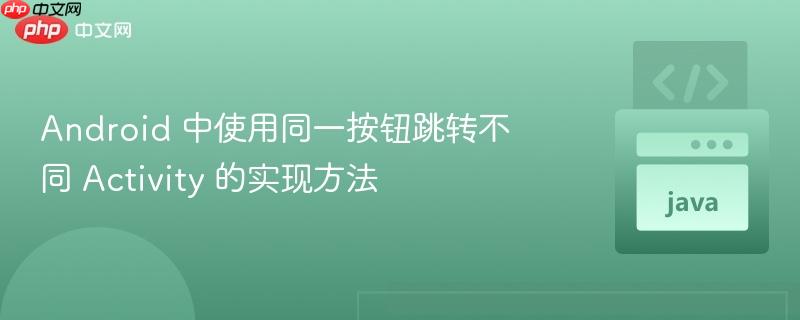
本文将介绍如何在 Android 应用中使用同一个按钮,根据不同的场景跳转到不同的 Activity。通过在 Activity 之间传递 ExtraKey,并根据 ExtraKey 的值来决定按钮点击后的跳转目标,可以实现灵活的页面跳转逻辑。
在 Android 开发中,经常会遇到这样的需求:同一个按钮,在不同的情况下,需要跳转到不同的 Activity。例如,用户首次点击按钮,跳转到 Activity A;当用户从 Activity A 返回后再次点击该按钮,则跳转到 Activity B。本文将介绍一种实现这种跳转逻辑的方法。
实现思路
核心思路是在 Activity 之间传递 ExtraKey,并根据 ExtraKey 的值来决定按钮点击后的跳转目标。具体步骤如下:
代码示例
以下是一个简单的示例,演示如何使用这种方法实现按钮跳转逻辑。
1. HomeActivity.java
import android.content.Intent;
import android.os.Bundle;
import android.widget.Button;
import androidx.appcompat.app.AppCompatActivity;
public class HomeActivity extends AppCompatActivity {
private Button buttonA;
private String activityState = "INITIAL"; // 初始状态
@Override
protected void onCreate(Bundle savedInstanceState) {
super.onCreate(savedInstanceState);
setContentView(R.layout.activity_home);
buttonA = findViewById(R.id.buttonA);
// 接收来自其他 Activity 的 ExtraKey
if (getIntent().hasExtra("ACTIVITY_STATE")) {
activityState = getIntent().getStringExtra("ACTIVITY_STATE");
}
updateButtonClickListener();
}
private void updateButtonClickListener() {
buttonA.setOnClickListener(v -> {
Intent intent;
if (activityState.equals("INITIAL")) {
intent = new Intent(HomeActivity.this, Activity1.class);
startActivity(intent);
} else if (activityState.equals("ACTIVITY1_CLOSED")) {
intent = new Intent(HomeActivity.this, Activity2.class);
startActivity(intent);
}
});
}
}2. Activity1.java
import android.content.Intent;
import android.os.Bundle;
import androidx.appcompat.app.AppCompatActivity;
public class Activity1 extends AppCompatActivity {
@Override
protected void onCreate(Bundle savedInstanceState) {
super.onCreate(savedInstanceState);
setContentView(R.layout.activity_1);
}
@Override
public void onBackPressed() {
Intent intent = new Intent(this, HomeActivity.class);
intent.putExtra("ACTIVITY_STATE", "ACTIVITY1_CLOSED");
startActivity(intent);
finish(); // 结束当前 Activity
}
}3. Activity2.java
import android.os.Bundle;
import androidx.appcompat.app.AppCompatActivity;
public class Activity2 extends AppCompatActivity {
@Override
protected void onCreate(Bundle savedInstanceState) {
super.onCreate(savedInstanceState);
setContentView(R.layout.activity_2);
}
}4. activity_home.xml
<LinearLayout xmlns:android="http://schemas.android.com/apk/res/android"
android:layout_width="match_parent"
android:layout_height="match_parent"
android:orientation="vertical"
android:gravity="center">
<Button
android:id="@+id/buttonA"
android:layout_width="wrap_content"
android:layout_height="wrap_content"
android:text="Button A"/>
</LinearLayout>5. activity_1.xml (示例)
<LinearLayout xmlns:android="http://schemas.android.com/apk/res/android"
android:layout_width="match_parent"
android:layout_height="match_parent"
android:orientation="vertical"
android:gravity="center">
<TextView
android:layout_width="wrap_content"
android:layout_height="wrap_content"
android:text="Activity 1"/>
</LinearLayout>6. activity_2.xml (示例)
<LinearLayout xmlns:android="http://schemas.android.com/apk/res/android"
android:layout_width="match_parent"
android:layout_height="match_parent"
android:orientation="vertical"
android:gravity="center">
<TextView
android:layout_width="wrap_content"
android:layout_height="wrap_content"
android:text="Activity 2"/>
</LinearLayout>注意事项
总结
本文介绍了一种使用同一个按钮跳转不同 Activity 的方法。通过在 Activity 之间传递 ExtraKey,并根据 ExtraKey 的值来决定按钮点击后的跳转目标,可以实现灵活的页面跳转逻辑。这种方法简单易懂,适用于各种复杂的跳转场景。希望本文对您有所帮助。
以上就是Android 中使用同一按钮跳转不同 Activity 的实现方法的详细内容,更多请关注php中文网其它相关文章!

每个人都需要一台速度更快、更稳定的 PC。随着时间的推移,垃圾文件、旧注册表数据和不必要的后台进程会占用资源并降低性能。幸运的是,许多工具可以让 Windows 保持平稳运行。

Copyright 2014-2025 https://www.php.cn/ All Rights Reserved | php.cn | 湘ICP备2023035733号